Conducting a Waste Audit
Conduct a waste audit to identify and quantify all the components of your organizations waste stream. What can be eliminated, reduced, reused or recycled?
What is a Waste Audit?
A waste audit involves the physical collection, sorting and weighing of a representative sample of your organization's trash. Depending upon your needs, a waste audit can focus on waste from the entire business or focus on certain areas, such as the cafeteria, manufacturing floor, or certain departments.
Why is a Waste Audit Necessary?
A waste audit will enable the organization to identify and quantify all the components of the waste stream. This knowledge is necessary to determine what components of the waste stream can be eliminated or reduced, exchanged, reused, sold, recycled, or composted. Knowing or extrapolating the results to determine quantities of items helps to identify not only which methods are best for waste diversion but also the recycling and composting companies best suited to handle the particular waste stream.
How to Perform a Waste Audit
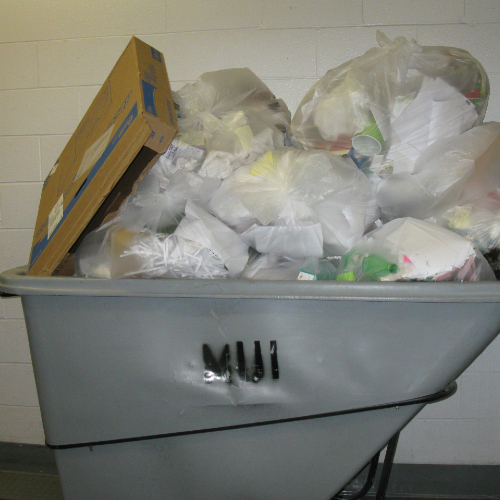
1) Collect your waste
Start your waste audit process by deciding how much of your facility's waste you want to collect. Choose one of the following:
- Collect one day worth of trash to sort
- Collect several day's worth of trash to sort if only a few bags are produced daily. Ideally, a minimum of 20-30 bags is a good representative sample for a waste sort.
- Collect waste separately from each department to be sorted separately the day before the audit.
However you choose to collect the sample, be mindful that waste generation may vary significantly from day to day and could distort results. Multi-day sampling provides a more accurate representation of any organization's waste stream. Schools tend to collect the trash from that day and do the audit after school.
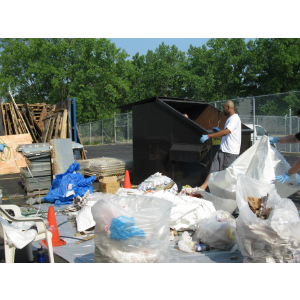
2) Gather your materials
You'll need some items to help you through the waste audit process. Have all of these items handy before you get started:
- Tarp, drop cloth, or plastic covering around 20ft x 20ft
- Scale with extension cord and nearby outlet
- Clipboard with pen or pencil, paper, black magic marker
- Hospitals and skilled nursing facilities should wear Tyvek suit and splash guard, respirator, double gloves, boots or sturdy shoes. For other facility audits, wearing old clothes and shoes along with gloves is appropriate. Do not wear open-toed shoes.
- Gloves - latex, nitrile, or heavy duty waterproof
- Eye protection
- Extra clear bags and extra trash bags
- Camera - can be a cell phone camera
- Duct Tape or similar tape to secure tarp to ground
- Waterproof containers or tubs for holding the materials for weighing. Usually 30 gallon to 50 gallon tubs will suffice for collection of items. Some items may be collected in smaller tubs, plastic bags or cardboard boxes.
- Labels for each container
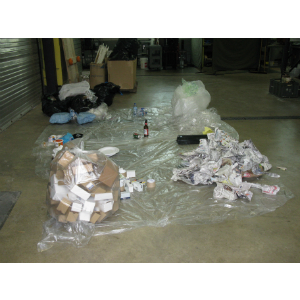
3) Start the sorting process
Let's get down to business.
- Gather the waste sample to be sorted.
- Tape the tarp down to the ground.
- Weigh the empty containers into which the samples will be sorted and record those weights on a label on each container.
- Be sure to record the number of bags being sorted and photograph them all together.
- Sort the waste sample by major components: plastic containers, glass bottles and jars, paper and chipboard, cardboard, aluminum and steel cans, compostable organics and trash.
- If applicable, sort other categories: electronics, pallets, wood debris, different packing materials, different grades of manufacturing plastics, Styrofoam blocks, construction and demolition debris, and other items specific to your industry.
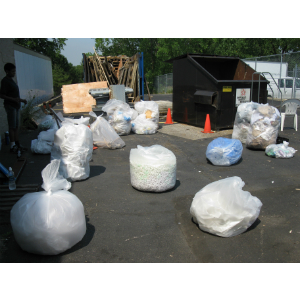
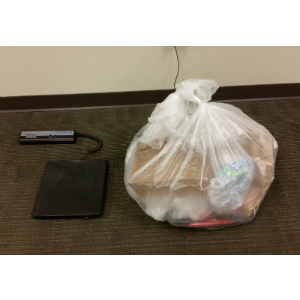
4) Weigh and photograph each category
On a worksheet, record the location and size of each container, dumpster or compactor from which you are sorting. Example: 55 gallon gray Brut, 8 yard front load container, 34 yard compactor.
Photograph each category separately. If an item has more than one collection container, photograph all the containers together with that particular item. If possible, get a group shot of all sorted items in their respective containers.
Visually inspect the group to determine the percent total of each item in the waste stream. Record this on the sheet as well. This percentage may end up different from percent by weight. For example, blocks Styrofoam takes up a lot of room but weigh very little. Therefore, a large amount of Styrofoam in the waste stream may greatly impact the volume but not the weight.
Once each category is sorted into a tub or container, weigh each one and remember to subtract out the tare weight to get the true weight of the item. Some items may take up multiple containers so be sure to add all weights together of a particular item. Use the worksheet to record the findings of your waste sort by filling in the columns with the weight of each material.
When the sort is complete:
- Calculate the total weight of material found within each waste receptacle.
- Calculate and record the total weight of each material found in all waste receptacles.
- Based on the total amount of waste sorted, calculate the percentage of each type of material found in all of the waste receptacles.
- Visually inspect the sorted items and determine percent by volume of the total waste stream for each item.
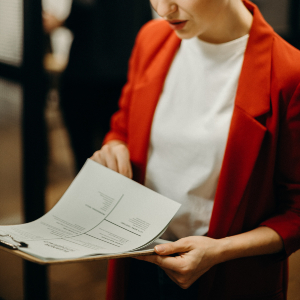
5) Analyze the waste audit data
Once the waste audit worksheet has been completed, you will know the weight and percentage of each type of material found in the waste stream. Based on this information you will now determine how to best divert or manage the items found in the waste stream through the various methods mentioned in the beginning.

6) Choose a recycling company
Based on the results, narrow down the recycling companies that will best suit your needs. Some companies haul both waste and recycling. Interview each company and have them visit your facility to show you how they wish to collect your items for pick up.
Good questions to ask:
- How long have you been in business?
- What do you recycle?
- What is your collection process?
- Do you give tours of your facility?
- Is there a contract I need to sign?
- Is there a minimum amount I need to have for pick up?
- Is there a charge for service?
- Can I get a rebate on my commodities?
- How are your charges determined?
- Do you provide free indoor containers?
- Do you have references?
Based on site visits and answers to these questions choose the recycling company or companies that best fit your needs. The Solid Waste District can assist with this process.
Learn More About Waste Audits

For more details about conducting a waste sort at your business or school, call our business recycling specialist at (216) 443-3732 or send an email.
